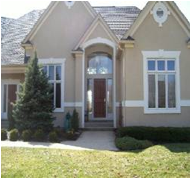DEFINITIONS
This portion of the Special Form policy defines the terms that are critical to understanding how the policy responds to coverage situations. The following is a summary of the defined terms that, throughout the policy, appear in quotation marks:
A. "You" and "your"
These are used in the policy to refer to the "named insured" who appears on the policy’s declarations. “You” and “your” also extend to the named insured's spouse, but only if he/she lives in the same household.
B. The HO 3 Special form policy also makes use of the following, defined terms:
5. The Special Form homeowner policy considers all of the following to be insureds (with notes on any exceptions):
• you
(refer to separate definition)
• your relatives if residents of "your" household
(meaning relatives who live at the insured location with the named insured)
• persons under the age of 21 residing in "your" household and in "your" care or in the care of "your" resident relatives
Note: Such persons must BOTH be younger than 21 AND have a named insured, his or her spouse or a relative of the named insured/spouse as their caregiver.
The definition of insured includes persons who are residents of the named insured’s household who are full-time students. In order for a full-time student to qualify as an insured, he or she must either be younger than 24 years of age and be related to an insured OR be younger than 21 years of age and be in the care of someone in the named insured’s household.
The following persons are insureds, but ONLY regarding section II, the liability portion of the homeowner policy:
• any party having legal responsibility for either animals or watercraft that are eligible for coverage under the homeowner policy.
Examples: Nancer Editbee’s home is insured by an ISO Special Form policy. Let’s look at whether the following are insureds under her policy:
• Nancer’s 12 year old neighbor who walks Nancer’s dog (yes, an insured)
• Frank, who rented Nancer’s RV for the weekend (no, not an insured – due both to rental and type of property)
• Jeri, a stranger who stole Nancer’s cat (no, not an insured)
• Paul, a friend from work who borrowed Nancer’s canoe (yes, an insured)
|

|
However, anyone in possession of an insured’s watercraft or animal is denied insured status if any business purpose is involved.
• any person working for an insured while operating a motor vehicle that qualifies for homeowner coverage,
• any person who has the insured’s permission to use an eligible motor vehicle, but only while on the insured premises.

|
Examples: Tom Kinpushion’s large home (on four acres of land) is insured with a Special Form homeowner policy. Let’s look at whether the following are insureds under his policy:
• Tom’s visiting childhood friend who hits Tom’s neighbor while driving Tom’s car out of his garage (no, not an insured)
• Tom’s neighbor, Pete, while using Tom’s lawn tractor in his (Pete’s) lawn cutting service (no, not an insured)
• Tom’s other neighbor’s daughter Nikki whom Tom hired to cut Tom’s 4 acres (yes, an insured)
• Tom’s son while using his electric wheelchair at the nearby grocery store (yes, an insured)
|
Related Court Case: “Automobile Exclusion Held Not Applicable To Liability Arising From Vehicle In Dead Storage”
The 05 11 edition of the Special Form policy’s definition of insured continues using a clarification. Whenever the word “insured” immediately follows the word “an,” the phrase refers to one or more “insureds.” In other words, an “insured” means one or more persons who have covered status under the policy.
6. “Insured location”
This term refers to a variety of circumstances that includes the following:
• the residence premises (please refer to the discussion of this defined term below).
• parts of other premises or structures that are used by an insured as long as these locations are shown on the policy declarations page OR have been acquired by the insured as a residence during the policy period.
Example: Annie’s home is covered by a Special Form policy. Annie also owns the lot that is next to her home. That adjacent lot contains a large garage. The garage was added to Annie’s homeowner policy by a separate endorsement. This garage is an insured location. |
• any premises that is related to a property that is covered by a Special Form policy AND which is used by an insured.
• a premise that IS NOT owned by an insured but is an insured location while it’s used by an insured as a residence.
Example: A hotel room while reserved and used by an insured. |
• vacant land that is owned by or rented to an insured EXCEPT farm land.
• land that contains a structure that will eventually be an insured’s (1 through 4) family residence.
Note: The building has to be for the insured’s residence. Land where an insured is building a residence that he plans to rent to another party would not be an insured location.
Other situations that qualify as an insured location include:
- an insured’s individual or family cemetery plots or burial vaults.
- part of a premises which is rented and used by an insured but only if for non-business purposes
Example:
Scenario 1 - Carson Prairie has a home insured by a Special Form policy. Carson is an alumnus of GardenView College. Every August, Carson rents his old dormitory room. He uses the time to recharge his batteries from his full-time job as an owner of a Pet Repo Service. The old dorm room is an insured location.
Scenario 2 - Let’s change something in the above situation. Again, Carson Prairie, the GardenView College alum, rents his old dormitory room every August. However, instead of for vacation and relaxation, he uses the room as a location to publish an online sports newsletter about GardenView to which he sells subscriptions to other sports-minded alumni. Besides the furniture from the college, Carson rents computers, copier and postal equipment to assist in his summer work. In this instance, his old dorm room is NOT an insured location.
|

|
Related Court Case: “Defamation Suit Denied - Unrelated To Insured Location” – Illustrates how an insurer’s obligation to provide coverage is affected by the relationship between a loss and the location of its occurrence.